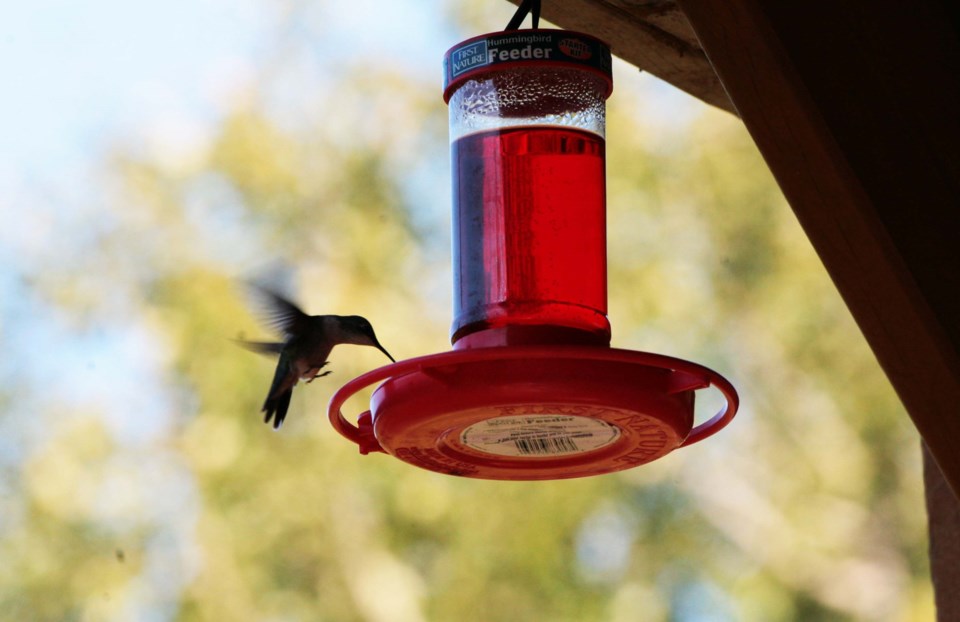Hummingbirds are truly remarkable and fascinating creatures. The smallest hummingbird is the Bee Hummingbird of Cuba and the Rufous Hummingbird has the longest avian migration in the world. They need to eat every 10 or 15 minutes and visit between 1000 and 2000 flowers each day.
The boreal forest is a supreme natural habitat for these little lovelies. In the spring the hummingbirds can enjoy native columbine, lobelia, horsemint, and beardtongue while as we move into summer and early fall available are the red lily, blanket flower, phlox, milkweed, harebell and monarda. We won’t venture into the less attractive but still necessary plants we call weeds. Let’s not forget the native woody species like the crab apple, chokecherry, Saskatoon berry, honeysuckle and dogwood. Also of course are the trees like poplar, ash, oak and birch when they are flowering in the spring.
For those of us who live outside of the forest fringe, we need to entice these birds during their migration to our gardens with bright, tubular flowers and if we choose to fill a feeder or two that is a good idea as well. Mix one-part sugar with four-parts hot water and stir until the sugar is completely dissolved. Let the mixture cool before putting it in the feeders. Do not add red dye. Fill the feeders with the mixture and change them often ensuring you clean them thoroughly to prevent mold growth. A solution of one-part white vinegar to four parts of water is a great solution for ensuring the feeder is cleaned properly. If the feeder has dirt stuck in it – add a few grains of rice and shake the vinegar solution vigorously and the grains will act as an abrasive. Rinse the feeder several times to ensure all traces of the cleaning solution have been removed. Feeders help ensure that hummingbirds have enough food to thrive. 90% of the diet of a hummingbird is made up of sugary nectar and to achieve this, hummingbirds have long bills and grooved tongues.
To attract hummingbirds, plant annuals in full sun areas like salvia, snapdragons, zinnia, nicotiana, petunias and geraniums. In shady areas, plant fuchsia, impatiens, begonia and morning glory. On the prairies, perennials like lupins, monarda, penstemon, columbine, foxglove, salvias and daylilies will keep these little critters happy as well as woody ornamentals like Ohio buckeye, lilacs and honeysuckles. Those of us who live in less severe zones can choose azalea, hibiscus, weigela, buddleia and butterfly bush. It is important to group similar plants together and ensure there is a steady supply of flowers for as long as possible during the growing season.
Other important things to include other than the flowers are areas where the hummingbirds can perch, the presence of insects and access to water. Having plenty of safe places for hummingbirds to rest and sleep is necessary. They do need protein in their diet and can snatch small insects in the air with specialized aerial manoeuvres. Minimize the use of pesticides to ensure the total environment that hummingbirds need is present. Spiders and other insects are important as young hummingbirds are almost exclusively fed insects.
Hummingbirds like to bathe often and can be seen bathing in the pools of droplets that collect on leaves. Provide a constant source of water from a drip fountain attachment or a fine misting device. In my yard, there is a waterfall made of limestone rocks forming tiny pools for hummingbirds to happily bathe in.
Hope you are enjoying our summer season with the added joy of watching hummingbirds.
— Hanbidge is the Lead Horticulturist with Orchid Horticulture. Find us at ; by email at [email protected]; on Facebook @orchidhort and on Instagram at #orchidhort. Tune into GROW Live on our Facebook page or check out the Youtube channel GROW



